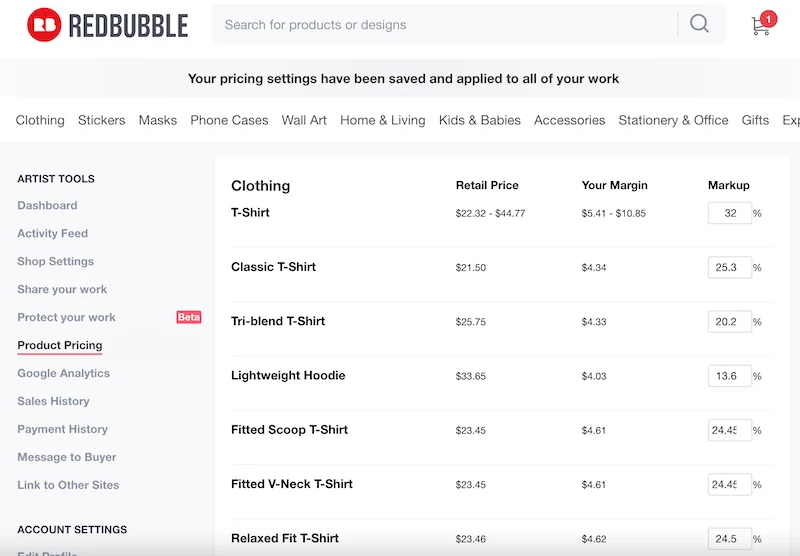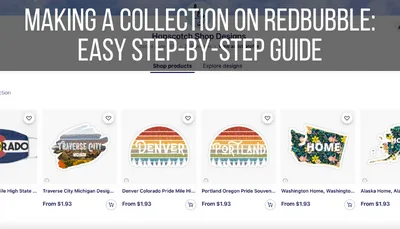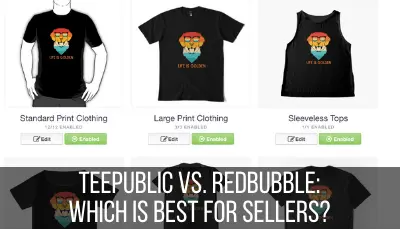Knowing how to edit and change your prices in your Redbubble store is key to making money as an artist and designer on their platform. Luckily, Redbubble makes it easy to change your prices so that you can make the profits you’re looking for.
To edit and change your prices in your Redbubble store, click on the Product Pricing button within your seller dashboard. From there, you will be able to markup your products by a percentage of your choice. Your markups will change the retail price of your products, as well as your profit.
To begin with, let’s look at how to access your Redbubble prices.
1. Navigate to your seller dashboard.
The goal here is to have the seller menu bar on the left-hand side appear. There are some pages that don’t have it, so navigating to the dashboard is a good bet for then accessing that menu bar.
2. Click on the “Product Pricing” button.
In the middle of your seller menu bar, you’ll see a “Product Pricing” button. When you click on it, you’ll be led to a page that includes the pricing for all of the products that Redbubble offers.

3. Adjust your Redbubble product pricing by determining markup percentages.
Go through each product and determine a percentage to markup each product by. Ok, but before doing so, let’s talk about these percentages.

Redbubble Uses Markup Percentages for Determining Product Pricing
Instead of entering a dollar amount that you would like to sell your products for, Redbubble bases their pricing on markup percentages. Redbubble will automatically enter in their costs related to the product and allow you to determine your profit margin by adding a markup to the product.
At first, Redbubble’s pricing can seem a bit awkward. Many of us would probably expect to pop into a pricing page and determine dollar amounts. That seems pretty reasonable, right?
Well, Redbubble’s pricing page relies on percentages.
When you adjust your product pricing on Redbubble, what you’re actually doing is adjusting the percentage that you’d like to markup your products by.
For example, let’s look at a classic t-shirt. If I put zero into the markup box, I’ll see that Redbubble will charge customers $17.16 for it. I would make no profit from that sale, so this is telling me that Redbubble’s costs related to that shirt are $17.16.
If I want to make a profit from the sale of that product, I need to add a markup to it. Just for example’s sake, let’s say 25%. This would raise the retail price to $21.45 and leave me with a profit of $4.29 per shirt sale.
$21.45 – $4.29 = $17.16
$17.16 was our retail price with our markup percentage at zero so, as you can see, our markup percentages translate directly into our profit margins.
Every markup can be adjusted individually. This means that you don’t need to have a blanket markup percentage for everything in your store.
Instead, you can determine a unique markup for every single product type that Redbubble offers. Not per design, but per product. This means that I can have a different markup for shirts, for water bottles, for mugs, etc.
While the percentages work, I really wish that Redbubble allowed you to simply enter in the product or profit prices you wanted.
Have you ever bopped around Redbubble’s site and wondered why the prices were so wonky? Instead of selling a sticker for $3, it might be sold for $3.13 or $3.26.
I love selling stickers and have a full guide on selling stickers on Redbubble. You won’t make a huge profit per sticker, but they can add up.
Luckily, all Redbubble prices look like this across their platform, so buyers get used to it. That said, my neurotic personality doesn’t. It drives me nuts. I admit, I just love clean and crisp numbers like $3 or $3.50.
The reason why Redbubble prices are so wonky is because of the markup percentages.
Let’s get back to our classic t-shirt example. At a 25% markup, the retail price is $21.45. I decide that the price is awkward and want it at $21.50. Well, there’s no quick and easy way to do that.

I need to play around with percentages at a decimal point level until I hit $21.50 exactly. It turns out that the percentage I need to do that is 25.3%.

It’s REALLY tedious going through every single product and establishing markup percentages down to the decimal point. Now, you may not have a problem with the wonky pricing, so this may not be a problem for you.
Or, if you’re like me, you learn to live with it because there are better things to do than worry about decimals for a long list of products.
That said, I just wish that Redbubble would do away with the percentages and allow sellers to use dollar amounts when establishing their product pricing. But, unless they make that change, the percentages are what they are and work well enough.
Alright, so we’ve discussed the logistics of establishing your pricing. That’s not the whole story though. You need a pricing strategy.
Consider Your Strategy When Establishing Your Redbubble Prices
It’s important to experiment with your Redbubble pricing so that you hit a balance between making enough profit and making sales. If your profit margin is too high, it may be challenging to get sales. If your profit margin is too low, it may be challenging to make enough money from your sales.
You don’t want your profit margins to be so low that your monthly earnings aren’t even worth it. On the other hand, you don’t want your profit margins to be so high that you scare away all of your customers.
Your design would have to be out of this world to sell it on a $70 shirt.
It’s important to strike a balance between profit and affordability so that selling on Redbubble is worth it to you.
Do some research and see how other sellers have established their prices. You want to be within that mix so that a customer isn’t shocked by the prices they see in your store.
You’ll also want to experiment. Are there price ranges where you see more sales come in than with other price ranges? This is a long-term project, as it takes time to see what prices are effective.
Setting your prices in your Redbubble store can feel tedious, but it’s the bread and butter of running an ecommerce store.
I love this platform because anyone can sell on Redbubble, which makes it such a neat opportunity for artists wanting to get started selling their work.
Spending time to establish your prices and an effective pricing strategy will help you set your store up for success.

Diana has been an artist for over 27 years and has training in drawing, painting, digital drawing and graphic design. Diana’s latest obsession is digitally drawing with Procreate and Procreate Dreams. Diana has experience selling her art across a number of platforms and loves helping other artists learn how to make money from their art as well.



